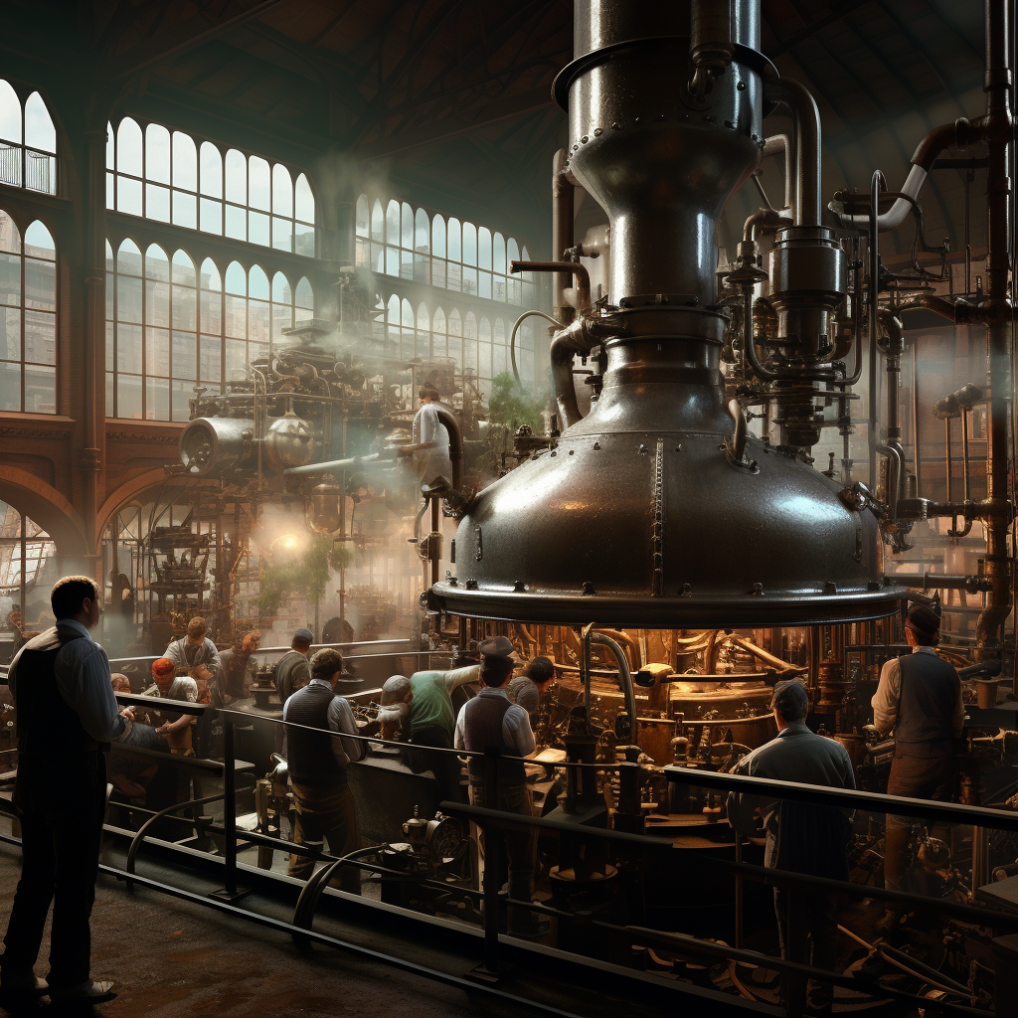
The Second Industrial Revolution holds a pivotal place in human history, leaving an enduring imprint on our contemporary world.
Its profound influence is defined by remarkable technological advancements and sweeping societal changes that have laid the very bedrock of the modern era.
While we relish the benefits stemming from this transformative period, it is imperative to acknowledge not only the positive advancements but also confront the challenges that came hand in hand with its far-reaching impact.
Second Industrial Revolution Facts
The Second Industrial Revolution, spanning from the mid-19th to early 20th century, was marked by a surge of technological advancements.
Here are some intriguing facts about this transformative era:
- Read also: How Did the Industrial Revolution Started
- Read also: Facts About The Harlem Renaissance
Fact #1: Technological leap
The Second Industrial Revolution heralded a remarkable departure from its predecessor by wholeheartedly embracing innovative sources of power.
Unlike the reliance on steam and water power witnessed in the first industrial revolution, this era underwent a revolutionary shift towards electric power and the internal combustion engine.
This transition not only bolstered efficiency but also laid the groundwork for a more dynamic and versatile industrial landscape, fundamentally altering the way we harness energy and power industrial processes.
Fact #2: Mass Production
A hallmark of the era was the advent of mass production, a game-changer propelled by innovations like the assembly line.
This transformative approach to manufacturing allowed for the rapid and standardized production of goods.
The assembly line’s introduction meant increased efficiency, reduced costs, and ultimately, the ability to meet growing consumer demands on an unprecedented scale.
Fact #3: Telecommunications boom
The Second Industrial Revolution witnessed the birth of a transformative era in communication.
The development of the telegraph and telephone sparked a telecommunications boom that forever changed the fabric of human interaction.
These inventions revolutionized long-distance communication, seamlessly connecting individuals and businesses across vast distances.
The world, once vast and distant, suddenly shrank, fostering increased collaboration and significantly accelerating the pace of global interactions, both in business and personal spheres.
Fact #4: Railroad expansion
One of the most visible and impactful changes during this era was the extensive expansion of railroads.
The proliferation of rail networks ushered in faster and more reliable transportation of goods and people.
This development not only streamlined supply chains, contributing to economic growth, but also played a pivotal role in interconnecting regions.
It fostered trade and cultural exchange, shaping a more interconnected and vibrant world.

Fact #4: Steel revolution
The Bessemer process revolutionized the production of steel during the Second Industrial Revolution.
This innovation made steel more affordable and accessible, leading to a surge in its use across various industries.
The robust and versatile nature of steel significantly impacted construction and transportation, providing the structural backbone for modern buildings and efficient modes of transit.
Fact #5: Urbanization surge
The Second Industrial Revolution sparked a rapid surge in urbanization, reshaping the demographic landscape as people flocked from rural areas to burgeoning industrial centers.
The allure of employment opportunities in these centers fueled mass migration, giving rise to sprawling cities and fundamentally altering the way people lived and worked.
Fact #6: Scientific advancements
The Second Industrial Revolution marked a period of remarkable progress in scientific understanding and application.
Breakthroughs in chemistry, physics, and biology laid the foundation for a wave of innovations across various industries.
These advancements not only deepened our comprehension of the natural world but also provided the knowledge base for the technological innovations that would follow.
Fact #7: Rise of corporations
Large-scale corporations emerged as prominent players in the economic landscape during this transformative period.
The expansion of industries and the surge in production necessitated the formation of powerful corporate entities.
These corporations, often wielding significant economic influence, played a pivotal role in shaping the economic structures of nations.
Fact #8: Impact on labor
While the industrial revolution fueled economic growth, it also brought to light concerns about labor conditions.
Issues such as excessively long working hours and poor workplace safety prompted the emergence of the labor movement.
Workers advocated for improved working conditions, fair wages, and better treatment, laying the groundwork for the establishment of labor rights that continue to shape workplace standards and practices.
Fact #9: Global influence
The influence of the Second Industrial Revolution echoed globally, leaving an enduring impact on economies and societies worldwide.
Industrialized nations emerged as key players in international trade and politics, reshaping the geopolitical landscape.
The newfound economic strength of these nations transformed global power dynamics, fostering intricate connections and dependencies on an unprecedented scale.
Fact #10: Environmental concerns
Rapid industrialization during this period came at a cost, with significant environmental consequences.
Increased pollution and resource depletion became unavoidable byproducts of the industrial revolution’s relentless march forward.
This led to a heightened awareness of the need for sustainable practices and environmental conservation.
Fact #11: Cultural and social changes
The Second Industrial Revolution was not confined to economic and technological shifts; it triggered profound cultural and social transformations.
Societies experienced shifts in lifestyle, education, and social structures as they adapted to the changing economic landscape.
The migration from agrarian to industrial societies brought about changes in traditional roles, family dynamics, and educational pursuits, fostering the emergence of modern societal norms.
Fact #12: Innovation legacy
The innovations born during the Second Industrial Revolution established a robust foundation for future technological advancements.
The spirit of innovation and progress ignited during this era continues to shape our contemporary world.
Technologies such as the internal combustion engine, electricity, and telecommunications, developed during this period, set the stage for subsequent waves of innovation.

Most Important Inventions of the Second Industrial Revolution
Several groundbreaking inventions defined the Second Industrial Revolution:
Electric Light Bulb (1879)
A transformative invention of the Second Industrial Revolution was Thomas Edison’s electric light bulb, introduced in 1879.
This groundbreaking innovation revolutionized both industry and daily life by providing a reliable and efficient source of illumination.
The widespread adoption of electric lighting not only extended working hours in factories and businesses but also transformed households, fundamentally altering how people lived, worked, and interacted after sunset.
Telephone (1876)
Alexander Graham Bell’s invention of the telephone in 1876 was a monumental leap forward in communication technology.
The telephone revolutionized the way people connected, breaking down geographical barriers and facilitating instantaneous communication.
This invention laid the foundation for the global connectivity we enjoy today, playing a pivotal role in business, personal relationships, and the dissemination of information.
Internal combustion engine (1885)
Karl Benz’s invention of the internal combustion engine in 1885 marked a key milestone in transportation history.
This innovative engine became the driving force behind the automotive industry, fundamentally changing the way people traveled.
The advent of automobiles not only revolutionized personal mobility but also had far-reaching impacts on industries, infrastructure, and urban planning, shaping the modern world’s transportation landscape.
Assembly Line (1913)
Henry Ford’s introduction of the assembly line in 1913 transformed manufacturing processes and became a cornerstone of the Second Industrial Revolution.
This innovation revolutionized mass production by streamlining assembly processes, making goods more affordable and accessible to a broader population.
The assembly line not only increased efficiency but also played a crucial role in shaping modern manufacturing practices and supply chain management.
Impact of the Second Industrial Revolution

Positive impacts
Economic growth
The Second Industrial Revolution brought forth an era of unprecedented economic growth.
The increased efficiency and mass production fueled by innovations such as the assembly line led to a surge in economic expansion.
Industries flourished, and nations experienced significant improvements in their GDP, laying the foundation for modern economic systems.
Technological advancements
Innovations like the telephone and electric light bulb significantly improved living standards and transformed daily life.
The telephone revolutionized communication, connecting people across distances, while the electric light bulb extended working hours and enhanced overall quality of life.
These technological advancements not only increased convenience but also laid the groundwork for further innovations in the decades to come.
Job opportunities
The industrial boom created a plethora of job opportunities, particularly in burgeoning urban centers.
As people migrated from rural areas to seek employment in factories and industries, urbanization surged.
This migration not only fueled job growth but also contributed to a significant increase in population, shaping the demographic landscape of many regions.
Negative impacts
Labor exploitation
The rapid industrialization of the era brought about harsh working conditions and labor exploitation in factories.
Long working hours, minimal job security, and inadequate workplace safety measures became prevalent issues.
The labor movement emerged in response to these challenges, advocating for improved conditions and workers’ rights.
Environmental impact
Increased industrial activity during the Second Industrial Revolution contributed to pollution and environmental degradation.
Factories released pollutants into the air and water, leading to adverse effects on ecosystems and public health.
This environmental impact prompted growing awareness of the need for sustainable practices and laid the groundwork for future environmental conservation efforts.
Social inequality
While the economic boom brought prosperity to certain segments of the population during the Second Industrial Revolution, it also cast a shadow of widening economic disparities.
Social inequality became more pronounced as some prospered, while others faced economic hardships.
This disparity in wealth distribution contributed to social tensions, laying the groundwork for discussions on social justice and the need for more equitable economic systems.
- Read also: Top 10+ Black History Facts You Need to Know
- Read also: The Most Impactful American History Events
Conclusion
The Second Industrial Revolution stands as a pivotal chapter in human history, exerting a profound influence that echoes through the world we inhabit today.
Characterized by monumental technological leaps and sweeping societal shifts, this transformative period laid the very foundation upon which the modern era is built.
As we continue to reap the benefits of this era, it becomes imperative to acknowledge not only the positive strides it brought forth but also to confront the challenges that accompanied its far-reaching impact.
FAQs
The Second Industrial Revolution marked a shift from steam and water power to electric power and the internal combustion engine. It introduced innovations like the assembly line, telecommunications, and mass production.
The era brought about significant improvements in daily life, including the introduction of electric light bulbs, telephones, and streamlined manufacturing processes. These innovations enhanced communication, accessibility, and overall living standards.
The Bessemer process, a key innovation of the era, revolutionized steel production. This led to the widespread availability of affordable steel, influencing industries such as construction and transportation.
Yes, the rapid industrialization led to social inequalities, harsh working conditions in factories, and environmental challenges. While it brought economic growth, it also raised concerns about labor exploitation and the impact on the environment.


